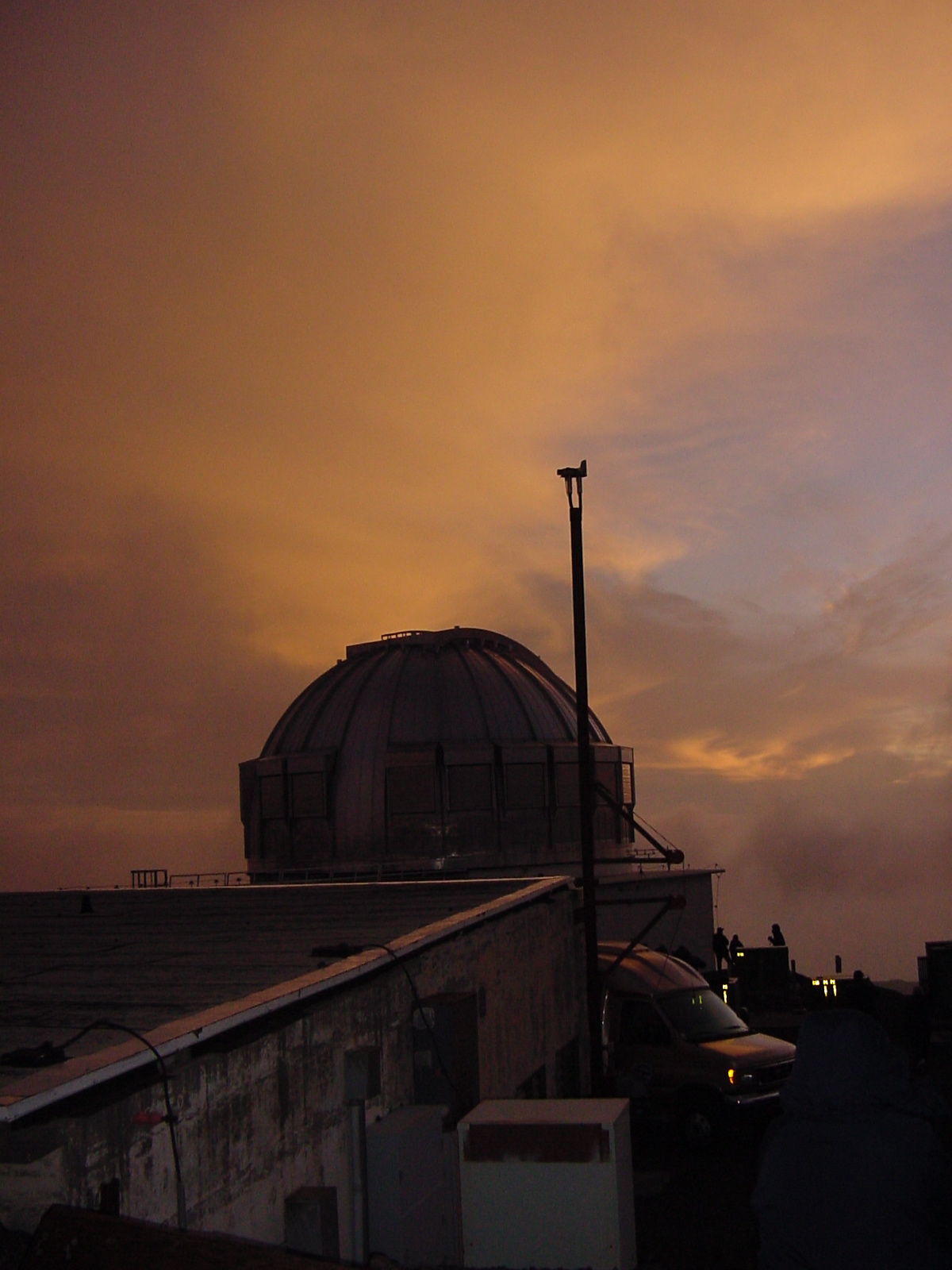|
United Kingdom Infrared Telescope
The United Kingdom Infra-Red Telescope (UKIRT) is a 3.8 metre (150 inch) infrared reflecting telescope, the second largest dedicated infrared (1 to 30 micrometres) telescope in the world. It is located on Mauna Kea, Hawai'i as part of Mauna Kea Observatory. Until 2014 it was operated by the Joint Astronomy Centre in Hilo. It was owned by the United Kingdom Science and Technology Facilities Council. UKIRT is currently being funded by NASA and operated under scientific cooperation between Lockheed Martin Advanced Technology Center, the University of Hawaii, and the U. S. Naval Observatory. The telescope is set to be decommissioned after completion of the Thirty Meter Telescope as part of the Mauna Kea Comprehensive Management Plan. Design Like related telescopes on Tenerife, it is a Cassegrain device with a thin primary mirror, around 2/3 thinner than in other contemporary devices and weighing only 6.5 tonnes. When trying to view distant objects in infra-red local sources of ... [...More Info...] [...Related Items...] OR: [Wikipedia] [Google] [Baidu] |
Arcsecond
A minute of arc, arcminute (arcmin), arc minute, or minute arc, denoted by the symbol , is a unit of angular measurement equal to of one degree. Since one degree is of a turn (or complete rotation), one minute of arc is of a turn. The nautical mile (nmi) was originally defined as the arc length of a minute of latitude on a spherical Earth, so the actual Earth circumference is very near . A minute of arc is of a radian. A second of arc, arcsecond (arcsec), or arc second, denoted by the symbol , is of an arcminute, of a degree, of a turn, and (about ) of a radian. These units originated in Babylonian astronomy as sexagesimal subdivisions of the degree; they are used in fields that involve very small angles, such as astronomy, optometry, ophthalmology, optics, navigation, land surveying, and marksmanship. To express even smaller angles, standard SI prefixes can be employed; the milliarcsecond (mas) and microarcsecond (μas), for instance, are commonly used in a ... [...More Info...] [...Related Items...] OR: [Wikipedia] [Google] [Baidu] |
List Of Largest Infrared Telescopes
The largest infrared telescopes for infrared astronomy are listed in terms of diameter of primary mirror. The infrared spectrum with its longer wavelength than visible light has a number of challenges, especially for ground-based observatories but also in space. Notably infrared radiation is emitted by all physical objects above Absolute Zero temperature so telescopes are subject to local interference. Overall Infrared observations from Earth's surface are possible in a limited way but can be very dependent on location and atmospheric conditions. Water vapour in the Earth's atmosphere blocks much of the infrared band, although some limited observations are possible and there is a number of infrared observatories. Sometimes other optical telescopes can make infrared observations if they are equipped with the right detectors, even if they are not dedicated infrared observatories. For ground-based observatories, the location can make a big difference in how much observation is po ... [...More Info...] [...Related Items...] OR: [Wikipedia] [Google] [Baidu] |
Gornergrat Infrared Telescope
The Telescopio InfraRosso del Gornergrat (TIRGO), or the Gornergrat Infrared Telescope, was located on the northern tower of the Gornergrat Kulm Hotel, Kulm Hotel at Gornergrat ( altitude) near Zermatt, Switzerland. It was a Cassegrain Reflector, Cassegrain telescope with a tip-tilt correcting secondary and optimized for infrared observations, but was decommissioned in March 2005. The telescope and related instrumentation were run by the Istituto di Radioastronomia (IRA - C.N.R.), sezione di Firenze (former CAISMI), with the assistance of the Osservatorio Astrofisico di Arcetri and the Dipartimento di Astronomia e Scienza dello Spazio of the University of Florence. See also *List of largest optical telescopes in the 20th century *List of largest infrared telescopes Infrared telescopes {{switzerland-struct-stub ... [...More Info...] [...Related Items...] OR: [Wikipedia] [Google] [Baidu] |
NASA Infrared Telescope Facility
The NASA Infrared Telescope Facility (NASA IRTF) is a telescope optimized for use in infrared astronomy and located at the Mauna Kea Observatory in Hawaii. It was first built to support the Voyager missions and is now the US national facility for infrared astronomy, providing continued support to planetary, solar neighborhood, and deep space applications. The IRTF is operated by the University of Hawaii under a cooperative agreement with NASA. According to the IRTF's time allocation rules, at least 50% of the observing time is devoted to planetary science. Telescope The IRTF is a 3.0 m (118" effective aperture) classical Cassegrain telescope. The Cassegrain focus f/ratio is f/38 and the primary mirror f/ratio is 2.5. Several aspects of the design of IRTF are optimized for IR observations. The secondary mirror is undersized to prevent the instrument from seeing the thermal emission from the telescope structure around the primary mirror. The primary mirror itself ... [...More Info...] [...Related Items...] OR: [Wikipedia] [Google] [Baidu] |

